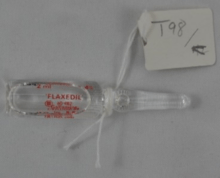Gallamine triethiodide
Gallamine triethiodide (Flaxedil) is a non-depolarising muscle relaxant.[1] It acts by combining with the cholinergic receptor sites in muscle and competitively blocking the transmitter action of acetylcholine.[2] Gallamine is a non-depolarising type of blocker as it binds to the acetylcholine receptor but does not have the biological activity of acetyl choline.Gallamine triethiodide has a parasympatholytic effect on the cardiac vagus nerve, which causes tachycardia[3][4] and occasionally hypertension. Very high doses cause histamine release.
 | |
| Clinical data | |
|---|---|
| Trade names | Flaxedil |
| AHFS/Drugs.com | International Drug Names |
| ATC code | |
| Identifiers | |
| |
| CAS Number | |
| PubChem CID | |
| IUPHAR/BPS | |
| DrugBank | |
| ChemSpider | |
| UNII | |
| KEGG | |
| ChEBI | |
| ChEMBL | |
| Chemical and physical data | |
| Formula | C30H60N3O3+3 · 3 I− (gallamine triethiodide) C24H45N3O3 (gallamine) |
| Molar mass | 891.529 g/mol (gallamine triethiodide) 423.633 g/mol (gallamine) |
| 3D model (JSmol) | |
| |
| |
| | |
Gallamine triethiodide is commonly used to stabilize muscle contractions during surgical procedures.
It was developed by Daniel Bovet in 1947.[5]
The pharmaceutical is no longer marketed in the United States, according to the FDA Orange Book.

References
- "Webster's Online Dictionary - Flaxedil". Retrieved 2008-12-15.
- "RxMed: Pharmaceutical Information - FLAXEDIL". Retrieved 2008-12-15.
- Morgenstern C, Splith G (October 1965). "[Studies on the causes of gallamine tachycardia and its antagonistic modification by beta adrenolytics]". Der Anaesthesist (in German). 14 (10): 298–301. PMID 4380161.
- Walts LF (1963). "Ventricular tachycardia with gallamine and cyclopropane anesthesia". Anesthesiology. 24: 119. doi:10.1097/00000542-196301000-00024. PMID 13998750.
- Raghavendra T (July 2002). "Neuromuscular blocking drugs: discovery and development". Journal of the Royal Society of Medicine. 95 (7): 363–7. doi:10.1258/jrsm.95.7.363. PMC 1279945. PMID 12091515.